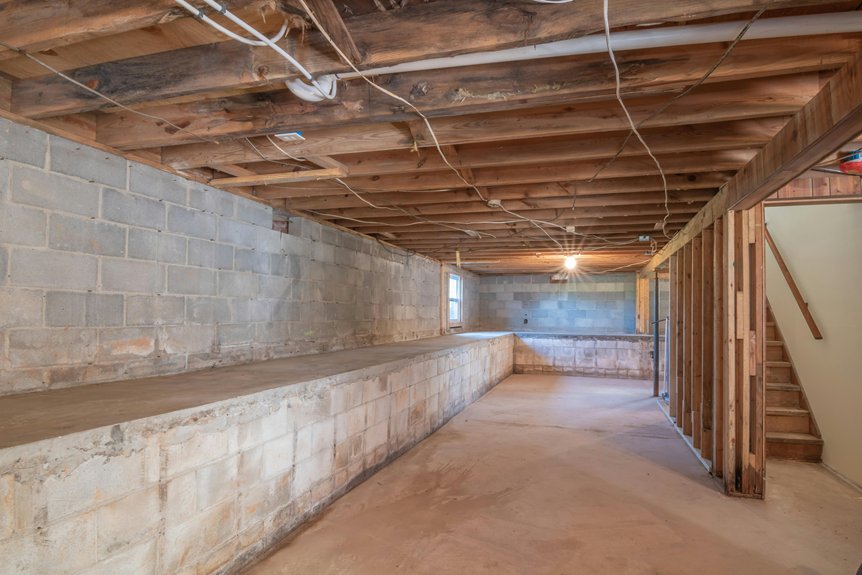When it comes to basement waterproofing, understanding moisture intrusion is key. You might notice signs like musty odors or condensation, indicating potential issues. Identifying the underlying causes—such as foundation cracks or poor drainage—is crucial before implementing solutions. This guide outlines effective interior waterproofing methods and maintenance strategies to guarantee your basement remains dry and protected. The right approach can make all the difference in safeguarding your home from water damage. Are you ready to explore these solutions?
Key Takeaways
- Evaluate and repair foundation cracks to prevent water seepage during heavy rains and address potential structural damage.
- Install an interior drainage system, such as a sump pump, to efficiently manage water accumulation in the basement.
- Use quality sealants and coatings on walls and floors to create an effective barrier against moisture intrusion.
- Ensure proper ventilation to reduce humidity levels and prevent condensation and mold growth in the basement.
- Regularly inspect and maintain waterproofing systems, including drainage and sealants, to ensure long-lasting protection against water damage.
Understanding Moisture Intrusion in Basements
When it comes to basements, understanding moisture intrusion is essential, as it can lead to significant structural damage and health issues.
You need to identify moisture sources like groundwater, rain infiltration, and condensation, which contribute to elevated basement humidity. High humidity levels can promote mold growth and compromise air quality, impacting your health.
Effective moisture management involves implementing proper drainage systems and vapor barriers to mitigate these risks. Regular monitoring of humidity levels and addressing any leaks promptly is important for maintaining a dry basement environment.
Common Causes of Basement Water Problems
Although you may not realize it, several factors can contribute to water problems in your basement. Understanding these issues is essential for effective waterproofing.
Here are three common causes:
- Foundation Cracks: Even minor cracks can allow water to seep in, especially during heavy rain.
- High Humidity: Excess moisture in the air can condense on cool basement surfaces, leading to dampness and mold.
- Poor Drainage: Inadequate grading or blocked gutters can cause water to pool around your foundation, increasing the risk of infiltration.
Addressing these causes can help prevent significant water damage in your basement.
Signs of Water Damage in Your Basement
You may notice unpleasant odors in your basement, which often indicate trapped moisture.
Visible mold growth is another critical sign, as it can compromise air quality and structural integrity.
Recognizing these signs early is essential for effective waterproofing and damage prevention.
Unpleasant Odors Present
Unpleasant odors in your basement often indicate underlying water damage that requires immediate attention.
Addressing these smells not only improves air quality but also prevents further structural issues.
Here are three key steps to take:
- Identify the Source: Investigate areas with moisture accumulation, as this can lead to persistent odors.
- Enhance Air Circulation: Use fans or dehumidifiers to improve airflow, which aids in moisture reduction and odor removal.
- Seal Cracks: Inspect and seal any foundation cracks to prevent water intrusion, minimizing future odor problems.
Taking these actions is essential for maintaining a healthy basement environment.
Visible Mold Growth
When visible mold growth appears in your basement, it often signals a serious water damage issue that demands immediate intervention.
Mold thrives in damp environments, indicating excessive moisture and inadequate air circulation. You must address the underlying water problem to prevent further growth.
Implementing effective mold remediation techniques, such as removing contaminated materials and using appropriate cleaning agents, is essential. Additionally, enhancing air circulation will help dry out the area and discourage mold recurrence.
Regularly monitor humidity levels and inspect for leaks to maintain a healthy basement environment. Ignoring mold growth can lead to structural damage and health risks.
Interior Waterproofing Methods
To effectively manage water intrusion in your basement, you should consider various interior waterproofing methods.
These include applying interior sealants and coatings, installing a sump pump, and understanding how exterior drainage systems can complement your efforts.
Each method plays a critical role in preventing moisture buildup and protecting your foundation.
Exterior Drainage Systems
While interior waterproofing methods focus on sealing off the basement from moisture intrusion, exterior drainage systems offer a proactive approach by managing water before it reaches your foundation.
Implementing effective drainage systems guarantees proper water diversion away from your home, minimizing potential damage.
- Gutters and Downspouts: Direct rainwater away from your foundation.
- French Drains: Channel groundwater away from the basement perimeter.
- Sump Pumps: Actively remove water accumulating around your foundation.
Interior Sealants and Coatings
Interior sealants and coatings serve as vital barriers against moisture intrusion, guaranteeing your basement remains dry and structurally sound.
You’ll find various sealant types, including polyurethane, epoxy, and silicone, each offering unique properties for different applications. For instance, epoxy sealants provide strong adhesion and durability, while silicone offers flexibility for dynamic cracks.
When applying coatings, surface preparation is essential; clean and dry surfaces guarantee ideal bonding.
Consider waterproofing paints as well, which can enhance aesthetics while providing moisture resistance.
Sump Pump Installation
A sump pump is an essential component of an effective interior waterproofing system, especially in areas prone to flooding or high groundwater levels.
Selecting the right sump pump types is vital for peak performance. Consider these factors during installation:
- Type: Choose between submersible or pedestal sump pumps based on your space and needs.
- Location: Install the pump in the lowest part of your basement for maximum efficiency.
- Maintenance: Regularly check the pump, clean the pit, and test the system to guarantee reliable operation.
Proper sump pump maintenance extends its lifespan and enhances your basement’s waterproofing efficacy.
Recommended Products for Basement Waterproofing
When it comes to guaranteeing a dry and secure basement, selecting the right waterproofing products is essential.
Start with high-quality basement sealants, which effectively create a barrier against moisture penetration. Look for products containing polyurethane or silicone for superior adhesion and flexibility.
Additionally, consider liquid-applied membranes that provide thorough coverage on walls and floors. For added protection, incorporate drainage systems or sump pumps to manage excess water.
Always evaluate product specifications and manufacturer recommendations to guarantee compatibility with your basement’s unique conditions.
Investing in reliable waterproofing products will safeguard your basement against moisture issues for years to come.
Maintenance Tips for a Dry Basement
To maintain a dry basement, regular inspections and proactive measures are essential.
Focus on these key areas:
- Check Basement Ventilation: Guarantee vents are clear and functioning to promote airflow, preventing moisture buildup.
- Monitor Humidity Levels: Use a hygrometer to keep humidity below 60%. If levels are high, consider a dehumidifier.
- Inspect for Leaks: Regularly check walls and floors for cracks or signs of water intrusion. Seal any gaps immediately.
Conclusion
To summarize, effectively waterproofing your basement requires a proactive approach to identify and address moisture intrusion. By understanding common causes and recognizing signs of water damage, you can implement appropriate interior waterproofing methods and utilize recommended products. Regular maintenance is essential in keeping your basement dry and healthy. Stay vigilant about monitoring humidity levels and inspecting for leaks, ensuring long-term protection against water damage and preserving your home’s structural integrity.

